If you’re considering buying a pellet stove for your home, you might wonder: does a pellet stove need a chimney?
The amazing thing about pellet stoves is that they don’t need a chimney. Homeowners can use a pellet stove by installing a horizontal venting system which is much cheaper and more effective than a chimney.
What if you already have a chimney? Let’s look at ways you can use your masonry chimney to work with your pellet stove.
But before that, let’s understand how a pellet stove works.
How Do Pellet Stoves Work?
Pellet stoves burn pellets to generate heat, which is then used to heat your room through heat exchangers. Additionally, Pellet stoves are eco-friendly and convenient to use. When comparing pellet and wood stoves, it’s important to note that while pellet stoves offer convenience and eco-friendliness, wood stoves may provide a traditional ambiance and potentially greater heat output.
Here’s a concise, step-wise explanation of the inner workings of a pellet stove:
Pellets
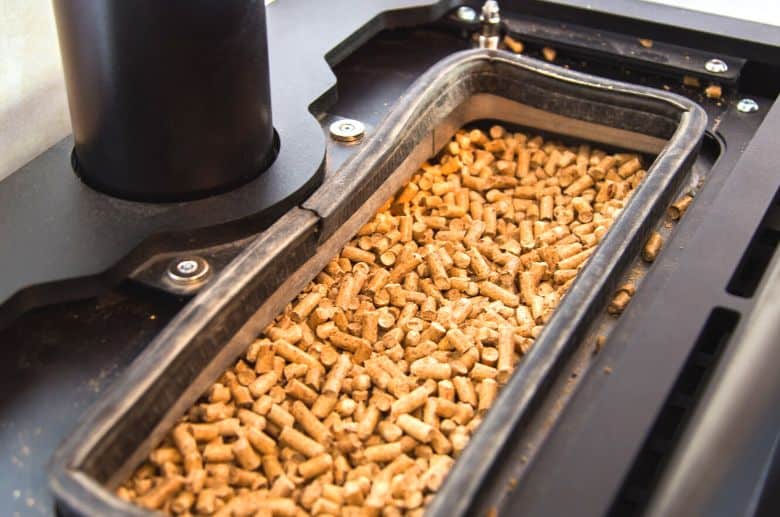
Pellets usually come in 40 lb bags that need to be stored in a completely dry area.
When you plan on starting up your stove, you add pellets into the hopper.
The hopper is a metal container usually storing up to 70 lbs of pellets. Hoppers come in two varieties: top hoppers and bottom hoppers.
Top hoppers are located above the burn pot. Since these hoppers are more fire-resistant, experts recommend them. Bottom hoppers are present below the burn pot, making it easy for homeowners to add pellets.
Auger and Thermostat
A pellet stove has an auger screw (made from cast iron) that moves the pellets from the hopper into the burn pot. While this mechanism is efficient, it’s not immune to potential pellet stove repair issues. For instance, the auger can jam or the motor that drives it may fail, leading to a disruption in pellet delivery and, consequently, heating efficiency.
Modern pellet stoves come with sensors that measure the number of pellets needed to achieve the temperature set on the thermostat.
When the amount of pellets in the burn pot (where the pellets are burnt) is low, a sensor checks it and signals the auger. Upon receiving the signal, the auger delivers the number of pellets needed to reach the set temperature in the burn pot.
To understand the process, suppose you have started your pellet stove and set the thermostat at 60 degrees Fahrenheit. The auger will start moving the pellets at a certain feed rate to reach this temperature, let’s say 1.5 pounds per hour. Once the set temperature is achieved, the auger feed rate will slow down and maintain that temperature.
Note: If you change the thermostat to a higher temperature, the auger will move the pellets faster. But the feed rate will be slower if you set a lower temperature.
Ignition and Combustion
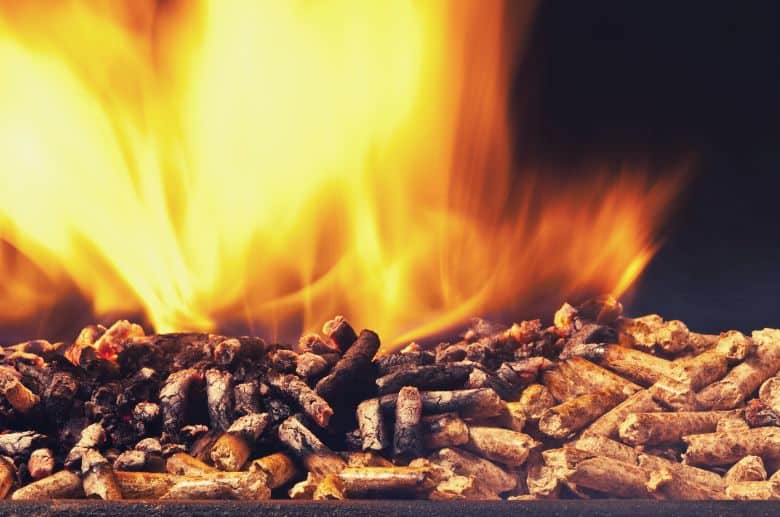
Two things are needed for combustion, fuel and oxygen. Pellets are used as fuel, while fresh room air provides the required oxygen. But how does ignition occur?
Modern pellet stoves use electrical ignition, press the thermostat button and an electric spark is induced. The spark ignites the pellets and kickstarts the burning process.
Heat Transfer
Pellet stoves use a convection blower that pulls fresh room air and passes it over the burn pot. The passing air makes the pellets burn hotter and more evenly.
As the room air passes through the burn pot, it becomes very hot. This hot air is passed through a heat exchanger, a series of iron bars.
The iron bars become hot because of the hot air. A blower transfers clean, hot air into the room through these heated bars.
Eliminating By-Products of Combustion
Even though complete combustion occurs inside pellet stoves, some ash is still produced. This ash is collected inside an ashtray located below the burn pot. Since pellet stoves produce only small amounts of ash, homeowners don’t have to clear out their ashtrays more than a couple of times a week.
Room air is passed over the burn pot during the heat transfer process, which heats the heat exchangers. Once the heat exchangers are hot, this air must be exhausted because it contains toxins and dangerous gases produced during combustion.
A blower is used to exhaust this unclean air into a piping system installed at the back of the pellet stove. The piping will then transfer the unclean air into a chimney or an exhaust pipe. Proper maintenance, including regular cleaning to address issues like pellet stove dust, ensures efficient operation and minimizes indoor air pollution.
How Do You Vent a Pellet Stove Without a Chimney?
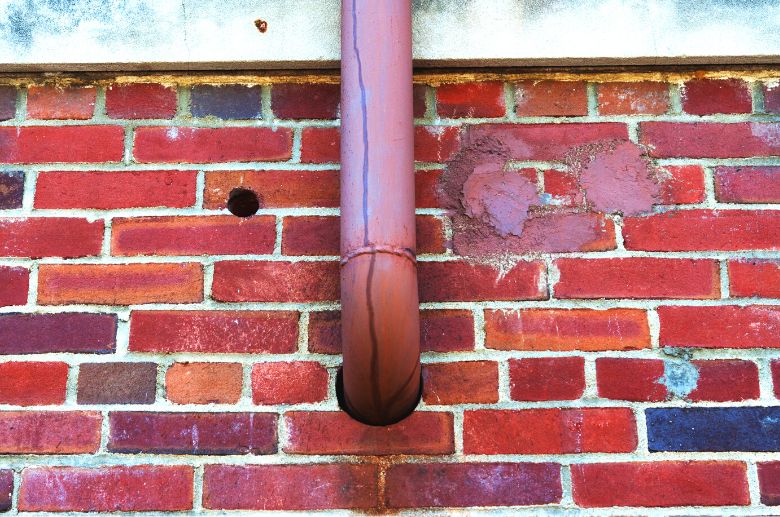
Pellet stoves don’t need a chimney to vent out exhaust air. If a chimney already exists, you can use it to exhaust unclean air. But if you don’t have a chimney, you can exhaust unclean air through a horizontal venting system.
A horizontal venting system is the most convenient and cost-effective way to exhaust unclean air from a pellet stove.
How to Install Horizontal Venting for a Pellet Stove
Note: The following guide should be used to understand a typical installation process. Always hire expert services for the project and follow the manufacturer’s installation manual.
Here’s a step-by-step process for installing a horizontal venting system for your pellet stove:
- Secure an adapter at the back of your pellet stove.
- Connect the vent pipe with this adapter.
- Attach an adapter plate to a wall.
- Pass the vent pipe through the adapter plate and ensure there are no leaks.
- Ensure the vent pipe extends 6 inches (at least) outside of the exterior wall.
Here is an animation that demonstrates the whole process.
Horizontal Venting With a Rise
Homeowners should consider a horizontal venting system with a rise. This is preferable because natural heat convection exhausts the hot, unclean air if your stove stops working due to equipment failure or fuel shortage. The unclean air can filter back into your room if there is no rise in the vent.
Homeowners can build the rise in the venting system inside the building (directly from your pellet stove) or outside.
Before installing a horizontal venting system, it is important to consider the local building codes and regulations:
- Your exhaust should be at a distance from doors and windows; the specified dimensions vary in different building codes.
- Add a protector plate on your wall to protect against wall discoloring.
- Install the vent 3 feet. (minimum) above any air intake pipe to prevent exhaust air recirculation.
- Your exhaust should not interfere with a pathway.
——
Do You Need to Hire Chimney & Fireplace Expert?
Get free quotes from qualified experts near you. No commitment required!
——
Is a Cold Air Intake Necessary for a Pellet Stove?
A cold air intake is not mandatory for all pellet stoves, but installing a fresh air kit for all pellet stoves is preferable. Oxygen is important for proper combustion. A continuous supply of fresh air from the outside ensures the pellets burn completely and evenly.
Certain building codes, as well as some pellet stove models, require a fresh air kit. If you’re unsure whether to install a fresh air intake for your pellet stove, consult a professional contractor.
Can You Vent a Pellet Stove Through an Existing Chimney?
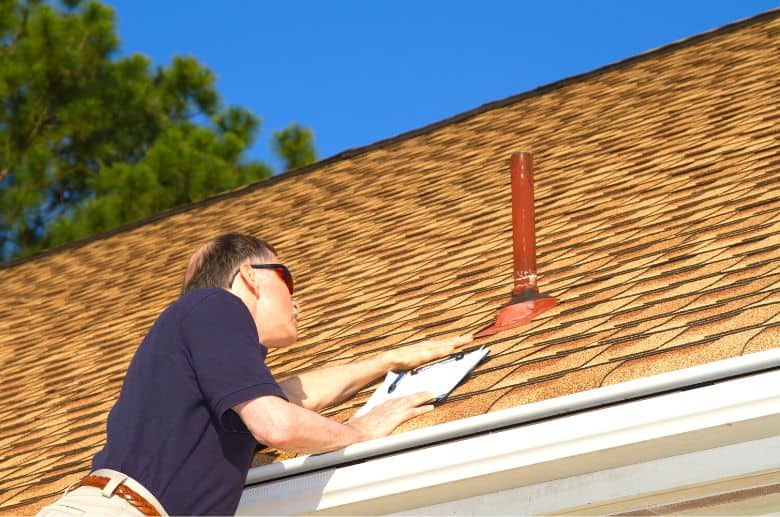
A pellet stove can vent through a chimney. If you already have a chimney, it will save you the hassle of cutting your wall or roof to pass a vent. But homeowners should take the following steps before venting a pellet stove through a chimney to ensure safety and efficiency:
Chimney Inspection
Hire a certified chimney sweep for a thorough inspection of your chimney. It will ensure that all parts of your chimney are working properly. If there are any broken parts or issues, such as creosote clogging, the chimney sweep will resolve them. You should only vent your pellet stove through a clean and properly functioning chimney to avoid the dangers of back-drafting or chimney fire.
The chimney sweep will also inspect the condition of your chimney flue. If your chimney flue is broken or missing, install a new one.
Also, install a chimney cap on top of your flue to protect it from rain, snow, and other environmental elements.
It is best to install half an inch of insulation around your chimney. It will keep the exhaust air hot, minimizing the possibility of creosote buildup.
Setting up the Pellet Stove
The chimney flue (liner) will attach to the back of your pellet stove through an adapter and extend up to the roof. The adapter must be clamped at the bottom of the chimney flue and properly sealed using a fire seal.
You must place the pellet stove inside the fireplace at a distance from surrounding walls and other objects. It will minimize the risk of nearby objects catching fire due to the radiation from the stove.
Once the pellet stove is in position, ensure the exhaust of the pellet stove is in line with the chimney flue. Then connect the two and make sure it is sealed properly.
If the connection is not sealed properly, the creosote can fall around the pellet stove and pose a fire risk. A secure connection ensures that the creosote falls into the stove, where it is burnt.
Hire a Professional
Pellet stoves come with manuals that have installation instructions. But it is best to hire a professional for the job. A certified chimney sweep will ensure the seal is secure and all clearances and standard practices are met.
And as a final safety check, get someone from the fire department to inspect the installation.
What Are the Dangers of a Pellet Stove?
Pellet stoves are safe heating appliances, especially since newer models have effective safety features. Still, homeowners must take precautionary measures and be vigilant when dealing with such appliances.
If you don’t take proper precautions, pellet stoves pose the following dangers:
Improper Installation
Pellet stoves need to be installed with proper clearance of nearby walls and other items that can catch fire. If the stove is placed close to combustible materials, the radiation from the stove can start a house fire.
Reigniting Embers
Pellet stove fires are rare, but they still occur. Usually, it is because of improper installation or lack of precaution.
One of the most common causes of pellet stove fire hazards is the mishandling of ash. Ash produced by a pellet stove accumulates in an ashtray under the stove. This ash often contains live embers that can reignite when exposed to air, leading to disastrous house fires.
It is important to store the ash in an air-tight metal bin for at least one day before throwing it away. This will give it enough time to cool down, preventing fire hazards.
Lack of Maintenance
Your pellet stove must be regularly cleaned, maintained, and inspected by a professional. Lack of proper maintenance can lead to blocked combustion air holes that can cause a fire that can reach the hopper or the electronics.
It is also important to use quality pellets for your stove. Moist or poor-quality pellets burn slowly, creating a buildup of unburned pellets. These pellets accumulate under the burn pot and suddenly ignite, causing a blast inside the stove.
Chimney Fires
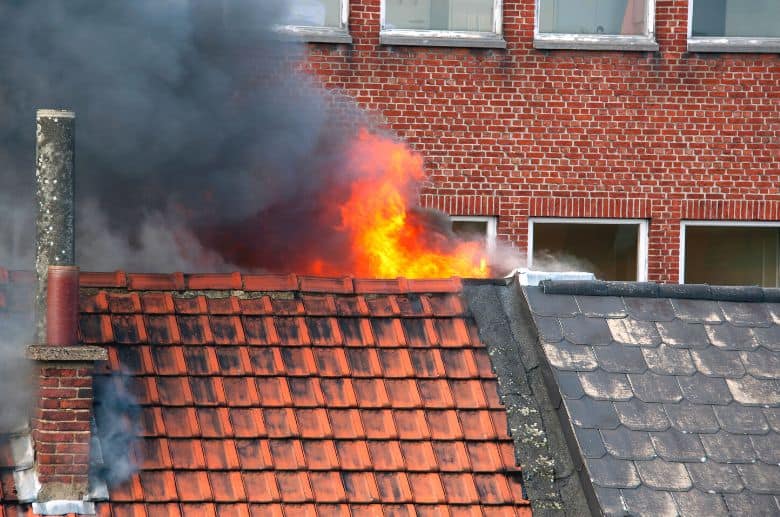
Pellet stoves produce relatively less ash and other toxic byproducts. But given enough time, creosote can build up inside your chimney. If your chimney is not regularly swept and inspected by a certified chimney sweep, the creosote buildup can clog the chimney and lead to a disastrous fire.
CO Off-Gassing
When wood pellets are stored, a chemical reaction produces carbon monoxide (CO). The CO off-gassing of pellet bags is dangerous, especially since CO is hard to detect because it is colorless and odorless. Prolonged exposure to CO can lead to headaches, nausea, and even death.
That is why storing pellet bags outside your home or building is important to avoid dire consequences. You should also install CO detectors where pellets are stored.
——
Do You Need to Hire Chimney & Fireplace Expert?
Get free quotes from qualified experts near you. No commitment required!
——
Can You Use a Pellet Stove as a Primary Heat Source?
You can use pellet stoves as a primary heat source. But not all pellet stove models are designed for this purpose. Usually, you’ll find pellet stoves that are used to heat a single room.
Since different types of pellet stoves are designed for different purposes, let’s find out which is best used as a primary heat source:
Freestanding Pellet Stove
The most common type of pellet stove is the freestanding pellet stove designed to heat the room it is installed in. Freestanding pellet stoves provide heat by blowing hot air into the room.
While some heat may dissipate into other rooms, it would not be enough. But if you have an open-plan house, installing a large freestanding pellet stove with sufficient output can heat your entire house.
Ducted Pellet Stove
A ducted pellet stove can be a viable solution if you plan to use your pellet stove as a primary heat source. As do the freestanding pellet stoves, ducted pellet stoves provide heat by blowing hot air. The difference is that a network of ducts is installed to convey hot air into other rooms.
The difficulty with ducted pellet stoves is that they must be customized according to your house plan. Another problem is that they’re not optimum for heating larger houses because the heat can travel only a certain distance from the stove.
Hydro Pellet Stove
A hydro pellet stove or pellet boiler looks like your typical freestanding stove. The only difference is that it does not have a vent at the front. The stove is connected to your central heating system from the backside.
These stoves offer a clean, efficient, cost-effective alternative to gas boilers for central heating. The only downside is that heating your house will take longer than a gas boiler.
Can a Pellet Stove Heat a Two-Story House?
A pellet stove can be used to heat a two-story house. But where you install the stove will determine how efficiently it will heat your house. For the best results, place the pellet stove near the stairs of your basement. Since heat rises, setting it on the lower floor will heat the rest of your house. The basement will not get warm if you place the stove on the ground floor.
Here are some other things you need to consider:
- It’s essential to decide on the right kind of pellet stove system, depending on the layout of your house.
- For an open concept layout, a freestanding pellet stove with sufficient capacity should be great.
- If you’ve got a sectioned layout with multiple rooms, a better choice would be a pellet stove that connects to a ducting system.
- You also need to factor in the living space; generally, a unit producing 60,000 BTU can heat a 2,000-square-foot space.
- If you live in colder climates, your heating unit must produce more heat to meet the required temperature.
- The same is the case with a house with poor insulation. Some heat will dissipate from your home, so your pellet stove must work more to cover the losses.
With all these factors at play, it can get complicated for a homeowner to decide. Hiring a professional to guide you through the process is best.
Pros and Cons of Pellet Stoves
Now that you’ve got a comprehensive understanding of pellet stoves and their various types, it’s time to weigh the pros and cons to see whether it meets your needs.
| Pros | Cons |
1. Cost-effectiveEasy to operate. 2. Cleaning is easy. 3. You just need to dump the ash a couple of times a week. 4. It’s easy and cheap to install. 5. You don’t need a chimney. But if you already have one, it can be used to vent the pellet stove. 6. You can control the thermostat through a button or remote control. 7. Pests free 8. Produces clean energy making it environmentally friendly. 9. Carbon-neutral source of heat. 10. Pellets are cheaper than propane. | 1. Due to various electronic parts, it requires more maintenance. 2. Need electricity. 3. Make noise. 4. Requires a backup system in regions with frequent power outages. 5. Pellets are more expensive than wood. 6. Pellets have CO outgassing. |
The Takeaway
Pellet stoves present a cheap and clean heating solution for your home. You don’t even need a chimney for a pellet stove. But if you already have a chimney, you can install a pellet stove inside the fireplace and use the chimney to vent out the exhaust gases.






